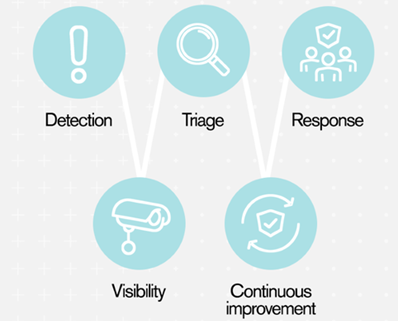
If you’re looking to enhance your organisation’s cyber security, you might have heard about something called a managed detection and response (MDR) service. If you’re wondering what MDR is, what it offers and how it differs to other managed cyber services, our FAQs have got you covered.
We’ve put all of your most frequently asked questions about managed detection and response (MDR) in one place. Click on any of the questions to find your answer:
- What is managed detection and response?
- How does managed detection and response work?
- Why is managed detection and response important?
- Does MDR replace SIEM?
- What’s the difference between EDR vs SIEM vs MDR?
- Do you need MDR and EDR if you already have antimalware solutions in place?
- Is MDR the same as CSOC?
What is managed detection and response?
Content+Cloud’s MDR service is a proactive 24/7 cybersecurity service designed to protect your endpoints against advanced cyber threats. It leverages Microsoft technology to carry out real-time monitoring to swiftly detect, investigate and respond to security incidents.
MDR goes beyond the security measures you might have in place like antivirus or antimalware by continuously monitoring your endpoints for threat activity. It provides a holistic approach to cybersecurity, leveraging the advanced capabilities of Microsoft Defender for Endpoint to identify and mitigate attacks.
How does managed detection and response work?
MDR works through detection, triage, response, visibility and continuous improvement.

Real-time monitoring tools offer continuous high-fidelity threat detection and alerting, with experienced analysts providing triage and investigation of threat alerts, including escalation to incident response where needed.
MDR includes 24/7 response to critical incidents and reporting on key performance indicators and activities. The service also undertakes tuning of detections and leverages automated response capabilities.
By adopting MDR, organisations can focus on core functions while benefiting from proactive cybersecurity measures.
Why is managed detection and response important?
The added protection of MDR is crucial due to the escalating sophistication of cyber threats. Organisations can gain proactive threat detection, real-time monitoring and expert incident response, bolstering their cyber security posture. Unlike the traditional antimalware software you might have in place, MDR helps mitigate the risk of data breaches, financial losses and reputational damage caused by advanced attacks before they can cause a material impact. It achieves this by going beyond typical malware signature analysis and looking for broader signals such as abnormal behaviour.
By outsourcing security operations to MDR providers, businesses can access specialised expertise, advanced technologies and 24/7 monitoring without the need for significant investments in infrastructure and resources. This proactive approach ensures timely threat identification, swift incident response and continuous improvement, all of which safeguards your critical assets and preserves business continuity.
Does MDR replace SIEM?
MDR does not replace Security Information and Event Management (SIEM), but complements it. In fact, it’s not a like-for-like comparison at all – SIEM is a cyber security product, while MDR is a cyber security service.
SIEM systems collect and analyse log data from various sources, providing centralised visibility into security events. MDR leverages SIEM data and enhances it with additional threat intelligence, real-time monitoring and incident response capabilities.
MDR fills the gaps in SIEM by providing proactive 24/7 monitoring for your endpoints, making it a valuable addition to your organisation’s cybersecurity infrastructure.
EDR vs SIEM vs MDR: what are the differences?
EDR, SIEM and MDR are distinct but interconnected cybersecurity solutions:
- Endpoint Detection & Response (EDR) is a technology and focuses on producing the broad real-time telemetry needed to monitor for threat activity and provides technical options in responding to threats on endpoints. It can typically do this largely with minimal configuration.
- Security Information and Event Management (SIEM) is a technology that collects and analyses log data from multiple sources to identify security events and enable centralised monitoring. A modern SIEM can take data from EDR as a source and collate this with data from other sources to further enhance detection and improve the fidelity of the alerts being generated. SIEMs typically require significant customisation to provide optimum benefits based on the investment being made.
- MDR is a service that adds human expertise and battle tested processes on top of EDR technologies like Microsoft Defender for Endpoint (MDE), offering proactive threat detection, 24/7 monitoring, intelligent response and reporting.
Do you need MDR and EDR if you already have antivirus solutions in place?
In short, yes. Our MDR service extends the threat detection and containment from a single point of attack that you’d get from antimalware to the entire attack chain.
Antimalware detects and typically contains only known malware attacks at the point of their impact – this means that the compromise must have already occurred to gain initial access – and it won’t be able to detect attacks it doesn’t recognise as ‘known bad’, for example, attacks that do not rely on malware.
MDR, on the other hand, focuses on monitoring and responding to threats across the wider attack chain. It provides real-time visibility and targeted response capabilities to help you rapidly deal with a broader set of attack techniques and mitigate impact to the business.
Is MDR the same as CSOC?
There are a few key differences between MDR and a cyber security operations centre (CSOC).



